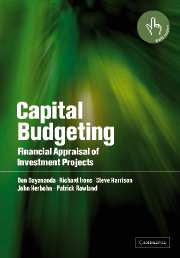Book contents
- Frontmatter
- Contents
- List of figures
- List of tables
- Preface
- 1 Capital budgeting: an overview
- 2 Project cash flows
- 3 Forecasting cash flows: quantitative techniques and routes
- 4 Forecasting cash flows: qualitative or judgemental techniques
- 5 Essential formulae in project appraisal
- 6 Project analysis under certainty
- 7 Project analysis under risk
- 8 Sensitivity and break-even analysis
- 9 Simulation concepts and methods
- 10 Case study in financial modelling and simulation of a forestry investment
- 11 Resource constraints and linear programming
- 12 More advanced linear programming concepts and methods
- 13 Financial modelling case study in forestry project evaluation
- 14 Property investment analysis
- 15 Forecasting and analysing risks in property investments
- 16 Multinational corporations and international project appraisal
- References
- Index
2 - Project cash flows
Published online by Cambridge University Press: 14 May 2010
- Frontmatter
- Contents
- List of figures
- List of tables
- Preface
- 1 Capital budgeting: an overview
- 2 Project cash flows
- 3 Forecasting cash flows: quantitative techniques and routes
- 4 Forecasting cash flows: qualitative or judgemental techniques
- 5 Essential formulae in project appraisal
- 6 Project analysis under certainty
- 7 Project analysis under risk
- 8 Sensitivity and break-even analysis
- 9 Simulation concepts and methods
- 10 Case study in financial modelling and simulation of a forestry investment
- 11 Resource constraints and linear programming
- 12 More advanced linear programming concepts and methods
- 13 Financial modelling case study in forestry project evaluation
- 14 Property investment analysis
- 15 Forecasting and analysing risks in property investments
- 16 Multinational corporations and international project appraisal
- References
- Index
Summary
An important part of the capital budgeting process is the estimation of the cash flows associated with the proposed project. Any new project will cause a change in the firm's cash flows. In evaluating an investment proposal, we must consider these expected changes in the firm's cash flows and decide whether or not they add value to the firm. Successful investment decisions will increase the shareholders' wealth through increased cash flows.
Valuing projects by estimating their net present values (NPV) of future cash flows is a means of gaining an idea of their expected addition to shareholder wealth. Correct identification of the relevant cash flows associated with an investment project is one of the most important steps in the calculation of NPV or in the project appraisal. Cash flow is a very simple concept, although it is easily confused with accounting profit or income. Cash flows are simply the dollars received and dollars paid out by the firm at particular points in time.
The focus of project analysis is on cash flows because they easily measure the impact upon the firm's wealth. Profit and loss in financial statements do not always represent the net increase or decrease in cash flows. Cash flows occur at different times and these times are easily identifiable. The timing of flows is particularly important in project analysis. Some of the figures in standard financial statements, such as income statements or profit and loss accounts, may not have a corresponding cash flow effect for the same period; some of their actual cash flows may occur in the future or might already have occurred in the past.
- Type
- Chapter
- Information
- Capital BudgetingFinancial Appraisal of Investment Projects, pp. 12 - 36Publisher: Cambridge University PressPrint publication year: 2002
- 1
- Cited by



